Jiazi Bu
$\text{G}^2$RPO: Granular GRPO for Precise Reward in Flow Models
Oct 02, 2025Abstract:The integration of online reinforcement learning (RL) into diffusion and flow models has recently emerged as a promising approach for aligning generative models with human preferences. Stochastic sampling via Stochastic Differential Equations (SDE) is employed during the denoising process to generate diverse denoising directions for RL exploration. While existing methods effectively explore potential high-value samples, they suffer from sub-optimal preference alignment due to sparse and narrow reward signals. To address these challenges, we propose a novel Granular-GRPO ($\text{G}^2$RPO ) framework that achieves precise and comprehensive reward assessments of sampling directions in reinforcement learning of flow models. Specifically, a Singular Stochastic Sampling strategy is introduced to support step-wise stochastic exploration while enforcing a high correlation between the reward and the injected noise, thereby facilitating a faithful reward for each SDE perturbation. Concurrently, to eliminate the bias inherent in fixed-granularity denoising, we introduce a Multi-Granularity Advantage Integration module that aggregates advantages computed at multiple diffusion scales, producing a more comprehensive and robust evaluation of the sampling directions. Experiments conducted on various reward models, including both in-domain and out-of-domain evaluations, demonstrate that our $\text{G}^2$RPO significantly outperforms existing flow-based GRPO baselines,highlighting its effectiveness and robustness.
Pref-GRPO: Pairwise Preference Reward-based GRPO for Stable Text-to-Image Reinforcement Learning
Aug 28, 2025Abstract:Recent advancements highlight the importance of GRPO-based reinforcement learning methods and benchmarking in enhancing text-to-image (T2I) generation. However, current methods using pointwise reward models (RM) for scoring generated images are susceptible to reward hacking. We reveal that this happens when minimal score differences between images are amplified after normalization, creating illusory advantages that drive the model to over-optimize for trivial gains, ultimately destabilizing the image generation process. To address this, we propose Pref-GRPO, a pairwise preference reward-based GRPO method that shifts the optimization objective from score maximization to preference fitting, ensuring more stable training. In Pref-GRPO, images are pairwise compared within each group using preference RM, and the win rate is used as the reward signal. Extensive experiments demonstrate that PREF-GRPO differentiates subtle image quality differences, providing more stable advantages and mitigating reward hacking. Additionally, existing T2I benchmarks are limited by coarse evaluation criteria, hindering comprehensive model assessment. To solve this, we introduce UniGenBench, a unified T2I benchmark comprising 600 prompts across 5 main themes and 20 subthemes. It evaluates semantic consistency through 10 primary and 27 sub-criteria, leveraging MLLM for benchmark construction and evaluation. Our benchmarks uncover the strengths and weaknesses of both open and closed-source T2I models and validate the effectiveness of Pref-GRPO.
DiCache: Let Diffusion Model Determine Its Own Cache
Aug 24, 2025


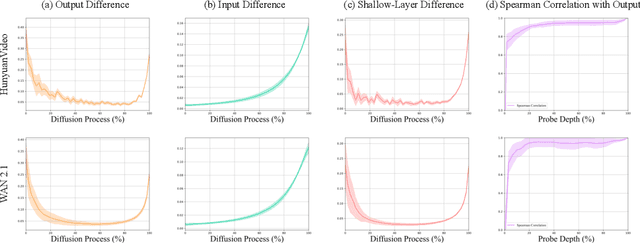
Abstract:Recent years have witnessed the rapid development of acceleration techniques for diffusion models, especially caching-based acceleration methods. These studies seek to answer two fundamental questions: "When to cache" and "How to use cache", typically relying on predefined empirical laws or dataset-level priors to determine the timing of caching and utilizing handcrafted rules for leveraging multi-step caches. However, given the highly dynamic nature of the diffusion process, they often exhibit limited generalizability and fail on outlier samples. In this paper, a strong correlation is revealed between the variation patterns of the shallow-layer feature differences in the diffusion model and those of final model outputs. Moreover, we have observed that the features from different model layers form similar trajectories. Based on these observations, we present DiCache, a novel training-free adaptive caching strategy for accelerating diffusion models at runtime, answering both when and how to cache within a unified framework. Specifically, DiCache is composed of two principal components: (1) Online Probe Profiling Scheme leverages a shallow-layer online probe to obtain a stable prior for the caching error in real time, enabling the model to autonomously determine caching schedules. (2) Dynamic Cache Trajectory Alignment combines multi-step caches based on shallow-layer probe feature trajectory to better approximate the current feature, facilitating higher visual quality. Extensive experiments validate DiCache's capability in achieving higher efficiency and improved visual fidelity over state-of-the-art methods on various leading diffusion models including WAN 2.1, HunyuanVideo for video generation, and Flux for image generation.
HiFlow: Training-free High-Resolution Image Generation with Flow-Aligned Guidance
Apr 08, 2025Abstract:Text-to-image (T2I) diffusion/flow models have drawn considerable attention recently due to their remarkable ability to deliver flexible visual creations. Still, high-resolution image synthesis presents formidable challenges due to the scarcity and complexity of high-resolution content. To this end, we present HiFlow, a training-free and model-agnostic framework to unlock the resolution potential of pre-trained flow models. Specifically, HiFlow establishes a virtual reference flow within the high-resolution space that effectively captures the characteristics of low-resolution flow information, offering guidance for high-resolution generation through three key aspects: initialization alignment for low-frequency consistency, direction alignment for structure preservation, and acceleration alignment for detail fidelity. By leveraging this flow-aligned guidance, HiFlow substantially elevates the quality of high-resolution image synthesis of T2I models and demonstrates versatility across their personalized variants. Extensive experiments validate HiFlow's superiority in achieving superior high-resolution image quality over current state-of-the-art methods.
Light-A-Video: Training-free Video Relighting via Progressive Light Fusion
Feb 12, 2025
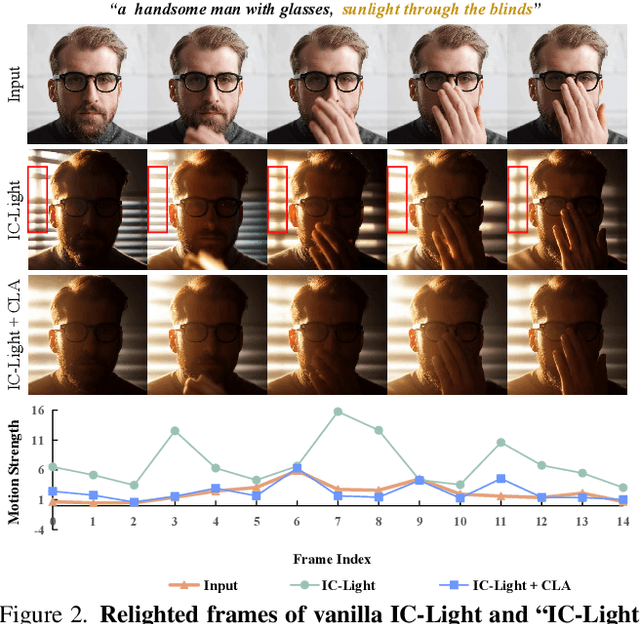
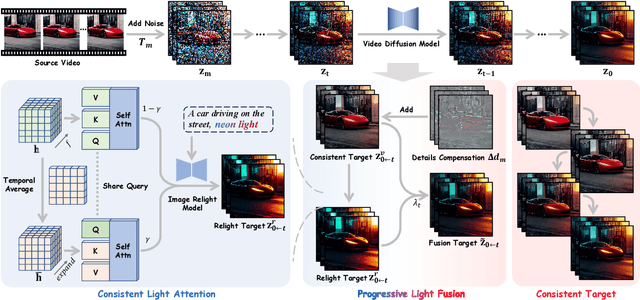
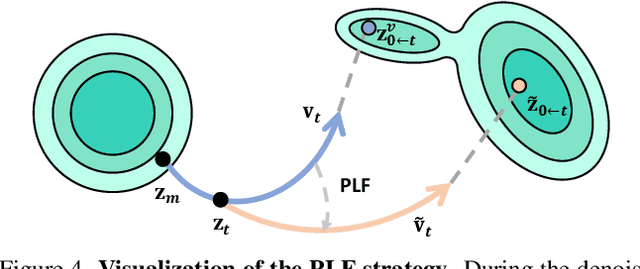
Abstract:Recent advancements in image relighting models, driven by large-scale datasets and pre-trained diffusion models, have enabled the imposition of consistent lighting. However, video relighting still lags, primarily due to the excessive training costs and the scarcity of diverse, high-quality video relighting datasets. A simple application of image relighting models on a frame-by-frame basis leads to several issues: lighting source inconsistency and relighted appearance inconsistency, resulting in flickers in the generated videos. In this work, we propose Light-A-Video, a training-free approach to achieve temporally smooth video relighting. Adapted from image relighting models, Light-A-Video introduces two key techniques to enhance lighting consistency. First, we design a Consistent Light Attention (CLA) module, which enhances cross-frame interactions within the self-attention layers to stabilize the generation of the background lighting source. Second, leveraging the physical principle of light transport independence, we apply linear blending between the source video's appearance and the relighted appearance, using a Progressive Light Fusion (PLF) strategy to ensure smooth temporal transitions in illumination. Experiments show that Light-A-Video improves the temporal consistency of relighted video while maintaining the image quality, ensuring coherent lighting transitions across frames. Project page: https://bujiazi.github.io/light-a-video.github.io/.
BroadWay: Boost Your Text-to-Video Generation Model in a Training-free Way
Oct 08, 2024



Abstract:The text-to-video (T2V) generation models, offering convenient visual creation, have recently garnered increasing attention. Despite their substantial potential, the generated videos may present artifacts, including structural implausibility, temporal inconsistency, and a lack of motion, often resulting in near-static video. In this work, we have identified a correlation between the disparity of temporal attention maps across different blocks and the occurrence of temporal inconsistencies. Additionally, we have observed that the energy contained within the temporal attention maps is directly related to the magnitude of motion amplitude in the generated videos. Based on these observations, we present BroadWay, a training-free method to improve the quality of text-to-video generation without introducing additional parameters, augmenting memory or sampling time. Specifically, BroadWay is composed of two principal components: 1) Temporal Self-Guidance improves the structural plausibility and temporal consistency of generated videos by reducing the disparity between the temporal attention maps across various decoder blocks. 2) Fourier-based Motion Enhancement enhances the magnitude and richness of motion by amplifying the energy of the map. Extensive experiments demonstrate that BroadWay significantly improves the quality of text-to-video generation with negligible additional cost.
MotionClone: Training-Free Motion Cloning for Controllable Video Generation
Jun 12, 2024Abstract:Motion-based controllable text-to-video generation involves motions to control the video generation. Previous methods typically require the training of models to encode motion cues or the fine-tuning of video diffusion models. However, these approaches often result in suboptimal motion generation when applied outside the trained domain. In this work, we propose MotionClone, a training-free framework that enables motion cloning from a reference video to control text-to-video generation. We employ temporal attention in video inversion to represent the motions in the reference video and introduce primary temporal-attention guidance to mitigate the influence of noisy or very subtle motions within the attention weights. Furthermore, to assist the generation model in synthesizing reasonable spatial relationships and enhance its prompt-following capability, we propose a location-aware semantic guidance mechanism that leverages the coarse location of the foreground from the reference video and original classifier-free guidance features to guide the video generation. Extensive experiments demonstrate that MotionClone exhibits proficiency in both global camera motion and local object motion, with notable superiority in terms of motion fidelity, textual alignment, and temporal consistency.
ViTree: Single-path Neural Tree for Step-wise Interpretable Fine-grained Visual Categorization
Jan 30, 2024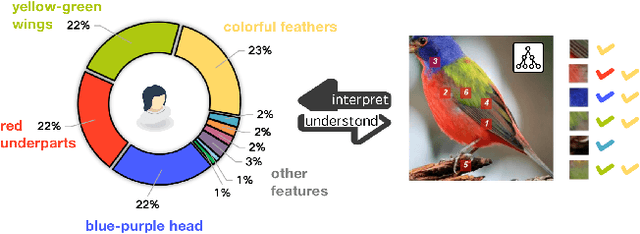
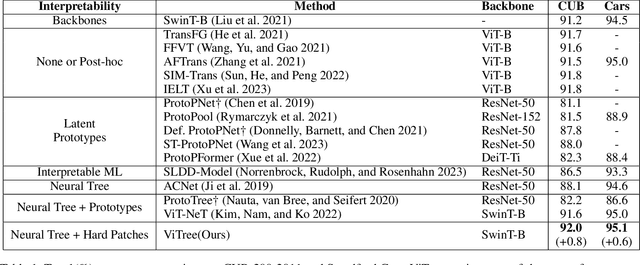
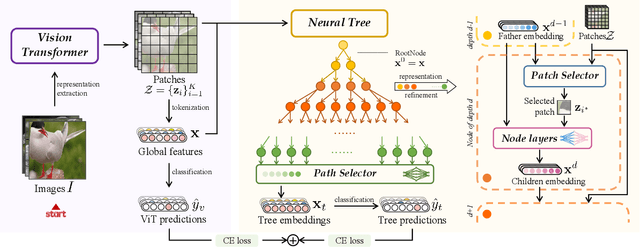
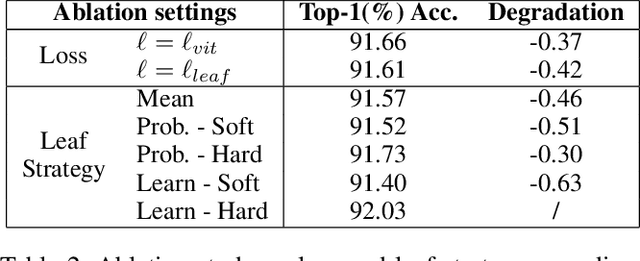
Abstract:As computer vision continues to advance and finds widespread applications across various domains, the need for interpretability in deep learning models becomes paramount. Existing methods often resort to post-hoc techniques or prototypes to explain the decision-making process, which can be indirect and lack intrinsic illustration. In this research, we introduce ViTree, a novel approach for fine-grained visual categorization that combines the popular vision transformer as a feature extraction backbone with neural decision trees. By traversing the tree paths, ViTree effectively selects patches from transformer-processed features to highlight informative local regions, thereby refining representations in a step-wise manner. Unlike previous tree-based models that rely on soft distributions or ensembles of paths, ViTree selects a single tree path, offering a clearer and simpler decision-making process. This patch and path selectivity enhances model interpretability of ViTree, enabling better insights into the model's inner workings. Remarkably, extensive experimentation validates that this streamlined approach surpasses various strong competitors and achieves state-of-the-art performance while maintaining exceptional interpretability which is proved by multi-perspective methods. Code can be found at https://github.com/SJTU-DeepVisionLab/ViTree.
MetaScript: Few-Shot Handwritten Chinese Content Generation via Generative Adversarial Networks
Dec 25, 2023Abstract:In this work, we propose MetaScript, a novel Chinese content generation system designed to address the diminishing presence of personal handwriting styles in the digital representation of Chinese characters. Our approach harnesses the power of few-shot learning to generate Chinese characters that not only retain the individual's unique handwriting style but also maintain the efficiency of digital typing. Trained on a diverse dataset of handwritten styles, MetaScript is adept at producing high-quality stylistic imitations from minimal style references and standard fonts. Our work demonstrates a practical solution to the challenges of digital typography in preserving the personal touch in written communication, particularly in the context of Chinese script. Notably, our system has demonstrated superior performance in various evaluations, including recognition accuracy, inception score, and Frechet inception distance. At the same time, the training conditions of our model are easy to meet and facilitate generalization to real applications.
 Add to Chrome
Add to Chrome Add to Firefox
Add to Firefox Add to Edge
Add to Edge